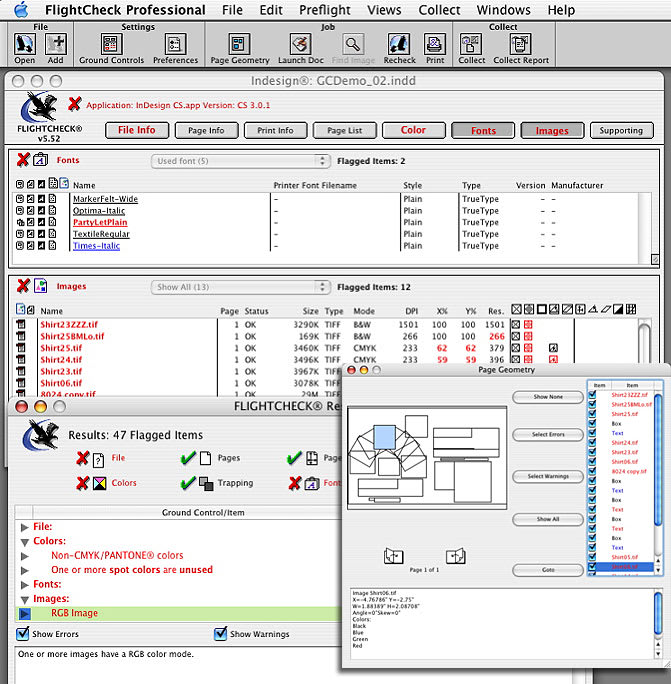

- #FLIGHTCHECK PROFESSIONAL MAC HOW TO#
- #FLIGHTCHECK PROFESSIONAL MAC MAC OS X#
- #FLIGHTCHECK PROFESSIONAL MAC INSTALL#
- #FLIGHTCHECK PROFESSIONAL MAC REGISTRATION#
Hold the left shift key while booting, until the progress bar shows. Locate the two files/folders (drivers) named SiLabsUSBDriver.kext and SiLabsUSBDriver64.kext, delete them (need admin-password).ģ. Browse to /System/Library/Extensions in FinderĢ.
#FLIGHTCHECK PROFESSIONAL MAC INSTALL#
With OS X it can be necessary to delete the old driver manually, then do a safe system-start, then install the new driver.ġ. Those who already have an older version will possibly have to make a safe system start once, to clear the driver caches. Those who install it for the first time won't have to do anything but install it. and the latest driver – a driver that will connect to ANY VBar, no matter how it's set up. Please also check out our FAQ for the product you have. Read me.txt – additional information especially for VBar NEO (key file) and current systems (Security Settings on the Mac).
#FLIGHTCHECK PROFESSIONAL MAC REGISTRATION#
VBar Control Manager – needed for updates and registration VBar NEO – the regular App for use with Express and Pro/Pro+Rescue VStabi Simulation – the App for playing around with the software without having a device connected VStabi Bluetooth – the App for use with a Bluetooth module to connect to your VBar

VStabi – the regular App for use with Express and Standard software There you find some apps brandishing the red V (5.x). The installation is typically Mac – unzip and open the DMG volume, then copy the VBar-Folder or VBar Files to your /Applications directory.

We appreciate any further info on what works and what doesn't. ġ0.3 might work, 10.2 on G4 Macs (Power PC chipset) doesn't, sorry.
#FLIGHTCHECK PROFESSIONAL MAC MAC OS X#
The following versions of OS X have been tested: Mac OS X 10.4.11-10.13.3 on MacBook Pro (Mid 2007, that's where the serial driver library has been developed on), iMac 24“ (Mid 2007), MacBook Air (2011), MacBook Air (2013), MacBook 12" (Mid 2017). By default, the latest software (corresponding to the latest PC-Software) is available. You find the download links on the VBar-Homepage. set xx to 8.The VBar-Software is running on recent and current Apple Macintosh Computers with Intel chipset. With systems using the decimal comma it fails if the running system uses the decimal period. How is it represented in Script Editor’s Result pane? It would also be helpful to know what the returned error is. Is it an AppleScript number or a textual representation? On the other hand, one of your posts calls it an “object reference”. You apparently have reason to think it’s a number. This last bit (‘arse_temp’ in cwtnospam’s last suggestion) is particularly useful for understanding why you get an error when you try to coerce it to text. I’m trying to feel my way to an understanding of whether the FlightCheck syntax is correct, whether ‘job’ is a FlightCheck element or the name of a variable, and what comes out when you try to get the ‘name’ of a ‘top level document’ held in a list.
#FLIGHTCHECK PROFESSIONAL MAC HOW TO#
Not having FlightCheck myself, I don’t know how to resolve your script. It means that FlightCheck doesn’t know how to resolve that particular reference. Is this flightchecks implementation/fault? ( FlightCheck Professional 6 got an error: Can’t get name of every top level document of job.) Set nameList to name of every top level document of job Set converted_number to zero & converted_number Set n to text (y + 1) thru -1 of this_number as number Set the converted_number to the first_part & second_part Set the second_part to text (x + 1) thru (z - 1) of this_number Set the first_part to text 1 thru (x - 1) of this_number Set y to the offset of "-" in this_number Set the converted_number to the converted_number & "0" The converted_number & character i of the second_part Repeat with i from 1 to the decimal_adjust Set the converted_number to the first_part Set the second_part to characters (x + 1) thru (z - 1) of this_number as string Set the first_part to characters 1 thru (x - 1) of this_number as string

Set the decimal_adjust to characters (y - (length of this_number)) thru ¬ Set z to the offset of "E" in this_number Set y to the offset of "+" in this_number Set x to the offset of "." in this_number It bothered me that the script didn’t work for negative exponents: set xx to 8.123456789E-10


 0 kommentar(er)
0 kommentar(er)
